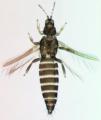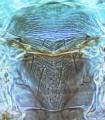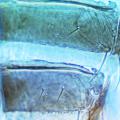Thrips orientalis
Recognition data
Distinguishing features
Both sexes fully winged with body and legs brown, but tarsi and apices of tibiae yellow; antennal segments III–VII paler than I–II; III mainly yellow, also base of IV & V; fore wings brown with base scarcely paler but with small white spot near veinal fork. Antennae 7-segmented, III–IV with sensorium forked. Head wider than long, ocellar setae pair III small and arising on anterior margins of ocellar triangle; postocular setae pairs I & III slightly shorter than ocellar setae III, postocular pair II minute. Pronotum with 2 pairs of long posteroangular setae; posterior margin with 3 pairs of setae. Metanotum reticulate medially, reticles with conspicuous internal sculptured markings; median setae arising behind anterior margin; campaniform sensilla absent. Fore wing second vein with complete row of setae; setal row on first vein highly variable on distal half, from almost complete to only 2 setae medially and 4 distally; clavus with 5 marginal setae, terminal seta shorter than subterminal. Tergite II with 3 lateral marginal setae; tergite VIII posterior margin with comb absent medially but with a few short microtrichia laterally; pleurotergites without discal setae. Sternal discal setae variable, absent on VII, 0–2 setae on II, but 1–3 on III–VI and placed laterally.
Male brown; tergite VIII with no posteromarginal comb; sternites III–VII each with broad transverse pore plate, discal setae often not developed.
Related and similar species
Recorded from Florida but not established in western USA, T. orientalis has been intercepted in quarantine in California several times on produce imported from Hawaii. It is one of a small group of Asian Thrips species, including Thrips parvispinus, in which discal setae are present on abdominal sternites III to VI but not on sternite VII. However, T. orientalis is variable in the chaetotaxy of the first vein on the fore wing, and also in the number of discal setae on the sternites. Rarely, a female is found with just a single discal seta on one sternite only, and such an individual is easy to misidentify. Thrips is the second largest genus in the Thysanoptera, and currently includes, worldwide, about 285 species. All members of the genus lack ocellar setae I on the head, and they all have ctenidia on tergite VIII posteromesad to the spiracles. Other characters, such as number of antennal segments, number of setae on the fore wing veins, and number of discal setae on the sternites are variable between species (Palmer, 1992; Nakahara, 1994; Mound & Masumoto, 2005).
Taxonomic data
Current valid name
Thrips orientalis (Bagnall)
Original name and synonyms
- Isoneurothrips orientalis Bagnall, 1915: 593
- Thrips setipennisSteinweden & Moulton, 1930: 25
- Thrips hispidipennis Hood, 1932: 122
Family placement
Thripidae, Thripinae
Biological data
Life history
Feeding and breeding in flowers
Host plants
Particularly associated with the flowers of Jasminum, Gardenia and Plumeria.
Tospoviruses vectored
None
Crop damage
Not known as a crop pest
Distribution data
Area of origin
Southeast Asia
Distribution
India, through Thailand and Malaysia to southern China and Japan; also northern Australia, New Caledonia, Tahiti and Hawaii in the Pacific region, Trinidad, Florida and Virgin islands in the Caribbean, and Tanzania in Africa. [Not yet recorded from California.]








